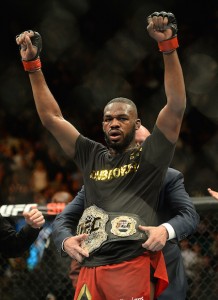Fresh on the heels of the UFC 182 buyrate report by MMAFighting’s Dave Meltzer, the time has come to evaluate pay-per-view as a channel and the UFC’s place in that channel.

In the time leading up to UFC 182, many projected the buyrate to surpass 1 million buys because page views and related searches fell in line with other events that did similar numbers. As the report states, the number of PPV buys is expected to fall somewhere between 740,000 and 820,000.
While the number fell below those initial expectations, it can be said that buyrate is still great by today’s standards. In today’s entertainment landscape, of which sports are a part, PPV is a declining revenue source for the UFC. In both 2012 and 2013, the UFC averaged roughly 450,000 PPV buys per event. In 2014, that number dropped significantly to roughly 300,000 PPV buys per event.
This decline is not exclusive to the UFC. Boxing has seen its problems as well. Manny Pacquiao has averaged below 500,000 buys for each of his last few fights. Floyd Mayweather, the perennial king of PPV, has seen less than 1 million buys in his last two bouts.
However, many would argue that the UFC has not done itself any favors with its expanded schedule and launch of UFC Fight Pass. By offering more events, either free on one of the FOX networks or Fight Pass, many fans may pass on what they view to be a watered down PPV and instead wait for the next free card. In regards to Fight Pass, asking fans to pay an additional $60 for each event, sometimes twice a month, when they already pay their $10 Fight Pass fee, can be a bit much.
Standard & Poor’s reported recently that Zuffa’s earnings were projected to decline 40% in 2014. While it is impossible to know for sure due to Zuffa being a private entity, it is likely that the decline in PPV revenue had a major impact on reduced profits.
So with an equally busy schedule in 2015, profits in decline and the PPV market trending downwards; the UFC brass need to go all in on FOX.
With the ever-changing television landscape, the rights fees to broadcast major professional sports are a hot commodity. The influx of subscription digital networks such as Hulu, Netflix, HBOGO, and Amazon Prime as well as the increasing consumer appetite for a la carte cable distribution has drastically increased the value of live television events.
For example, the NFL stands to receive roughly 40 billion from 2014 to 2022 for the rights to televise their product. Major League Baseball rights fees are at an all-time high, albeit in a slightly different, more local model. The Super Bowl and the Oscars, both live, are the two most watched broadcasts of the year.
This is not to compare the UFC to the NFL, MLB or the Oscars. It is to simply state that there is a massive opportunity available to them. The UFC has done a very admirable job in recent years integrating the sport into the daily American sports diet. The next step is to fall in line with the other major sports in terms of distribution.
Go all in during the final 2 years of the FOX deal. Decrease the number of PPVs to 3 or 4 per year. Put some of the biggest fights and best cards on FOX. This would allow for dramatically improved the content on FOX and FOX Sports 1. With better content and increased promotional efforts resulting in much higher ratings, the UFC could potentially make themselves attractive enough to drive up the rights fees of their next deal, with whatever that may be, to an unforeseen number.
Much like anything, none of this is a guarantee and it would certainly be a major gamble. However, remaining stagnant and hoping to grow cannot be an option. The UFC needs to get out in front of the issues that face them. Or dare I say the UFC needs to “Face the Pain”?
